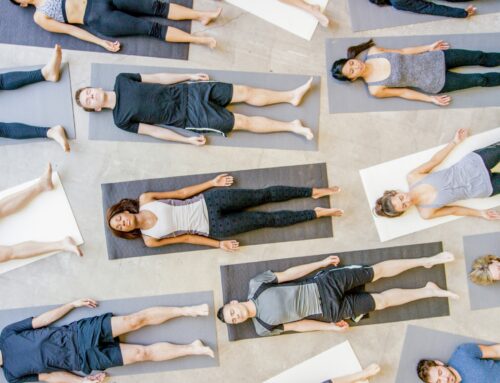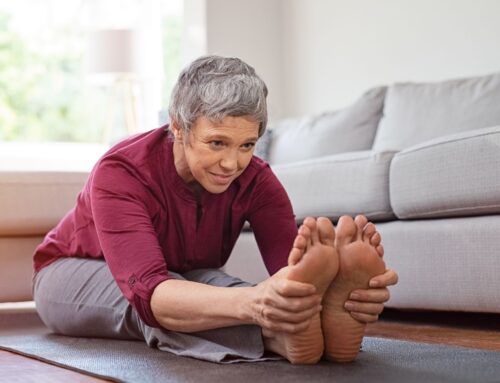If you’re one of the 80% of people who have suffered from back pain, you know the struggle to find a solution all too well. Maybe you have tried pain medication, chiropractic, massage, and group yoga classes but the pain keeps coming back.
What if a few small, simple changes in your daily habits could improve your back pain?
If you have been struggling with pain returning after you’ve tried everything, there may be some changes you can make between appointments and classes that will improve your pain and your quality of life.
Sitting is the New Smoking
You have probably heard the surprising claim, “sitting is the new smoking.” It is credited to James A. Levine, MD, PhD of the Mayo Clinic (also the inventor of the treadmill desk). Dr. Levine – and numerous other health professionals since – made this connection because of how strongly sedentary lifestyles and long periods of sitting are connected to increased health risks and mortality.
In the years since, many corporations and companies have started implementing strategies to help make office work healthier and safer for their employees.
Standing desks, sit-stand desks, company fitness programs and health incentive programs are now commonplace in corporate America.
COVID-19 Changed All That
How often have you found yourself checking email from your sofa, kitchen table or even in bed?

When COVID-19 sent millions of employees home to work, they lost access to the health benefits their employer’s wellness programs offered. Gyms and yoga studios closed. The kids were also sent home, disrupting routines. And employees had to quickly set up workstations in areas of the home that were not intended for that purpose.
Maybe you have yet to invest in an ergonomic desk chair because of the expense or uncertainty about how long work-from-home will last.
During your workday, you might be worried about leaving your computer for too long to avoid appearing offline or missing an important communication.
Even though work-from-home has increased convenience and reduced time sitting in cars commuting, overall, the shift to working from home may have contributed to more time spent sitting.
Not only that, but also more time spent sitting on surfaces that were not designed for computer and desk work.
And that could be translating into more back pain for you.
If this describes your situation, it may be time to change your routine.
More and more companies are beginning to plan for employees to continue working remotely even after children go back to school and it’s safe to be in the office. For many employees, work-from-home is here to stay.
Hack Your Work Routine for Less Pain without Decreasing Productivity
Begin by assessing your workstation.
If the only space available to you was designed for eating or resting, such as the dining room table, find a healthier alternative to the dining room chair.

Most dining room chairs offer little support over long periods of sitting. You can find an ergonomic desk chair or stool online or at your local office supply store.
Even a simple exercise ball can be a better alternative to a soft chair that encourages slouching.
If you don’t have the space or funds to implement a sit-stand desk, you can create your own by stacking boxes to elevate your monitor and keyboard.
“Desk Yoga” Can Help
The practice of “Desk Yoga” or practicing modified yoga postures from your workspace is one of the simplest and most impactful ways you can hack your work routine.
Desk Yoga does not require rolling out a mat or even leaving your desk (or kitchen table).
Ten minutes of desk yoga stretches every half an hour can help reduce pain, tension and discomfort.
The mindfulness element of yoga helps improve productivity, focus, and mental clarity.
Try This Exercise
Read the following instructions through and then try this exercise from wherever you are seated.
- Sit forward in your seat with two feet planted firmly on the floor
- Sit up straight (engage your core muscles to keep yourself from slouching)
- As you breathe in slowly, roll your shoulders up to your ears.
- As you breathe out slowly, roll your shoulders back and down, relaxing as you release.
- Repeat five times total, remembering to breathe and move slowly with attention on the breath and movement.
Try the exercise before reading on.
How did your mind react to that exercise? Was it easy and relaxing? Difficult or triggering?
How did your physical body react? Did you notice a change? Was there a subtle change, a very noticeable change, or no change at all?
Noticing your mental and physical reaction is part of the exercise.
Challenge
To make this exercise a little bit more challenging (but also more rewarding!) try this:
Slow the breath and the movement way down.
Make a conscious attempt to time the movement so that your shoulders roll up as far as they will go at the very end of your inhale, so that you are syncing the movement with the breath.
Make a conscious attempt to bring your shoulders down all the way at the very moment you finish your exhale. It may take a number of repetitions to be able to completely sync the breath and the movement.
Again, at the end of the exercise, notice the effect on your mental state and your physical body.
“How Will This Help My Back Pain?”
You may be asking yourself how shoulder rolls will improve your back pain.
Yoga is system of movement and breath that affects the entire body and mind. Not only were you rolling your shoulders, but also you were sitting up straight, bringing your spine into alignment and engaging your core muscles, which includes your back muscles.
The slow, mindful sends signals to your nervous system that it can relax, helping to relax muscles and reduce pain signals.
Its recommended that you change positions and spend time moving around every half an hour.
If you follow that guideline, you will be bringing your back out of unhealthy, slouching, static postures, working your core muscles and releasing tension all day throughout your work day. Not to mention practicing deep breathing and reducing your stress levels.
It’s the cumulative effect of a consistent practice that helps to reduce your pain.
Try this exercise every half an hour during time spent sitting for the next couple of days.
You can even add in your own version of breathing with movement such as raising arms up overhead or twisting side to side.
After breathing and moving in your seat, stand up and add in some time spent moving and walking around to make your desk yoga break even more effective.
Keep Practicing
- To fully reduce and eventually eliminate your back pain, consistency and flexibility are key.
- Arrange your ergonomic workstation to support your daily routine and don’t hesitate to change things up if something isn’t working.
- Set your timer or an app to remind you to move and change positions during your workday.
- And, continue desk yoga movement, mindfulness and breathing throughout the week to experience the full benefits of the practice.
For a full 10 minute desk stretch video delivered right to your email inbox, fill out your email below and have it delivered right to your inbox.
Interested in scheduling a full hour Desk Yoga practice for your company? Fill out my contact form now to schedule a virtual workshop for you and your team.




